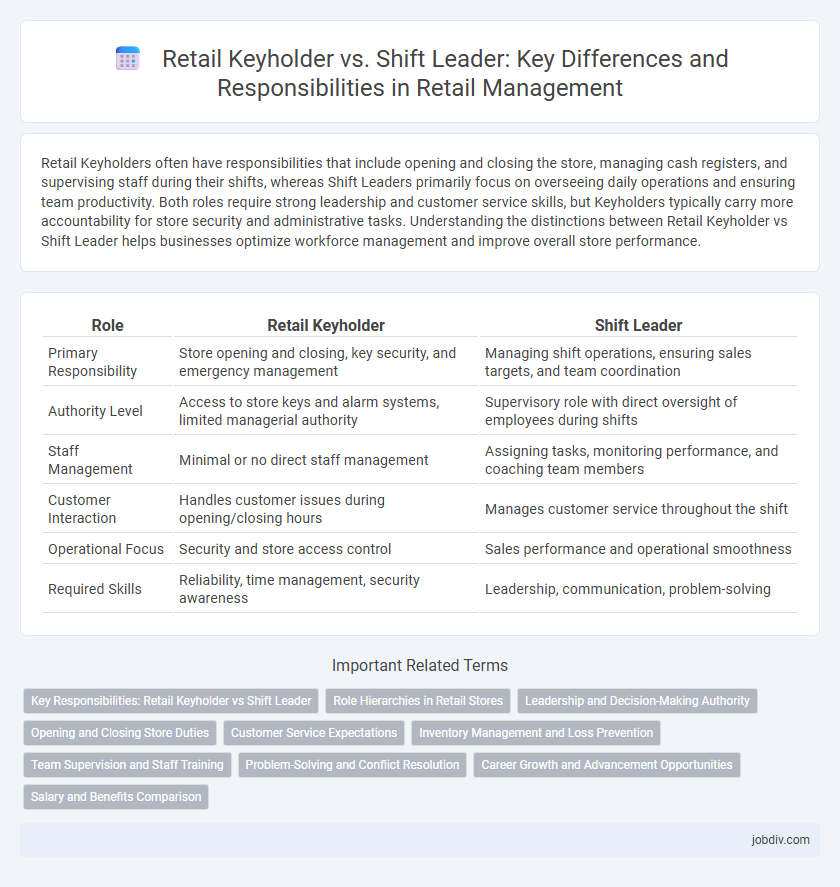Retail Keyholders often have responsibilities that include opening and closing the store, managing cash registers, and supervising staff during their shifts, whereas Shift Leaders primarily focus on overseeing daily operations and ensuring team productivity. Both roles require strong leadership and customer service skills, but Keyholders typically carry more accountability for store security and administrative tasks. Understanding the distinctions between Retail Keyholder vs Shift Leader helps businesses optimize workforce management and improve overall store performance.
Table of Comparison
| Role | Retail Keyholder | Shift Leader |
|---|---|---|
| Primary Responsibility | Store opening and closing, key security, and emergency management | Managing shift operations, ensuring sales targets, and team coordination |
| Authority Level | Access to store keys and alarm systems, limited managerial authority | Supervisory role with direct oversight of employees during shifts |
| Staff Management | Minimal or no direct staff management | Assigning tasks, monitoring performance, and coaching team members |
| Customer Interaction | Handles customer issues during opening/closing hours | Manages customer service throughout the shift |
| Operational Focus | Security and store access control | Sales performance and operational smoothness |
| Required Skills | Reliability, time management, security awareness | Leadership, communication, problem-solving |
Key Responsibilities: Retail Keyholder vs Shift Leader
Retail Keyholders primarily manage store security, cash handling, and opening or closing the premises, ensuring daily operational compliance. Shift Leaders oversee team coordination, staff scheduling, and customer service quality during their shifts to maintain smooth store functions. Both roles require strong leadership skills, but Shift Leaders focus more on employee management while Keyholders emphasize operational and security responsibilities.
Role Hierarchies in Retail Stores
In retail stores, the keyholder holds a crucial role with access to store keys and security systems, often positioned above sales associates but below store managers. Shift leaders manage daily staff operations, ensuring smooth shifts and customer service, typically reporting to keyholders or store managers. This hierarchy ensures clear responsibility distribution, with keyholders focusing on security and store opening/closing, while shift leaders emphasize team coordination and operational flow.
Leadership and Decision-Making Authority
Retail keyholders possess significant decision-making authority, including opening and closing the store, managing cash registers, and addressing customer issues, often stepping in as acting managers during shifts. Shift leaders primarily focus on supervising staff activities, ensuring operational tasks are completed efficiently, and supporting the keyholder or store manager with day-to-day team leadership. Leadership in retail keyholders involves broader responsibilities with greater autonomy, whereas shift leaders concentrate on direct team oversight and task execution within established guidelines.
Opening and Closing Store Duties
Retail Keyholders typically have responsibilities that include opening and closing the store, managing cash handling processes, and ensuring security protocols are followed during these critical times. Shift Leaders oversee store operations throughout their shifts, including delegating opening and closing tasks, supervising team performance, and addressing customer service issues. Both roles are essential for maintaining store integrity and smooth daily operations, but Keyholders generally carry more accountability for store access and security.
Customer Service Expectations
Retail Keyholders are responsible for opening and closing the store, managing keys, and ensuring security protocols while maintaining consistent, high-quality customer service by addressing shopper concerns and supporting staff on the floor. Shift Leaders primarily oversee daily team operations during their shifts, prioritize resolving customer issues promptly, and motivate employees to deliver exceptional service standards. Both roles demand strong communication skills and a proactive approach to enhancing customer satisfaction and store performance.
Inventory Management and Loss Prevention
A Retail Keyholder holds primary responsibility for securing inventory through managing access control and conducting regular audits to prevent shrinkage. Shift Leaders oversee daily operations, including supervising staff to ensure adherence to loss prevention protocols and monitoring inventory levels during their shifts. Both roles play crucial parts in maintaining accurate stock records and minimizing theft or inventory loss.
Team Supervision and Staff Training
Retail Keyholders primarily handle securing the store while also supporting daily team supervision by delegating tasks and ensuring operational standards are met during shifts. Shift Leaders focus more extensively on staff training, coaching team members to enhance customer service skills and operational efficiency. Both roles contribute to team management, but Shift Leaders have a stronger emphasis on developing employee performance and team cohesion.
Problem-Solving and Conflict Resolution
Retail Keyholders primarily handle problem-solving related to daily store operations, such as managing inventory discrepancies and addressing customer service issues, ensuring smooth shifts in the absence of store managers. Shift Leaders focus more on conflict resolution within the team, mediating disputes among staff and maintaining a productive work environment to meet sales targets. Both roles require strong communication and decision-making skills, but Keyholders emphasize operational problem-solving while Shift Leaders specialize in interpersonal conflict management.
Career Growth and Advancement Opportunities
Retail keyholders often manage store operations during closing hours and assist in opening, offering foundational leadership experience essential for career growth. Shift leaders typically hold broader responsibilities, overseeing team performance, store compliance, and customer service during shifts, which positions them for advancement into supervisory or managerial roles. While both roles provide leadership exposure, shift leaders usually have greater opportunities for upward mobility within retail management hierarchies.
Salary and Benefits Comparison
Retail Keyholders typically earn between $12 and $16 per hour, with benefits including employee discounts and limited paid time off, while Shift Leaders often receive higher pay, ranging from $14 to $20 per hour, alongside more comprehensive benefits such as health insurance and bonus potential. Shift Leaders generally enjoy greater responsibilities that justify increased compensation and enhanced benefits packages compared to Keyholders. Salary differences reflect the leadership and operational duties undertaken by Shift Leaders, making their roles more financially rewarding within retail management.
Retail Keyholder vs Shift Leader Infographic

 jobdiv.com
jobdiv.com